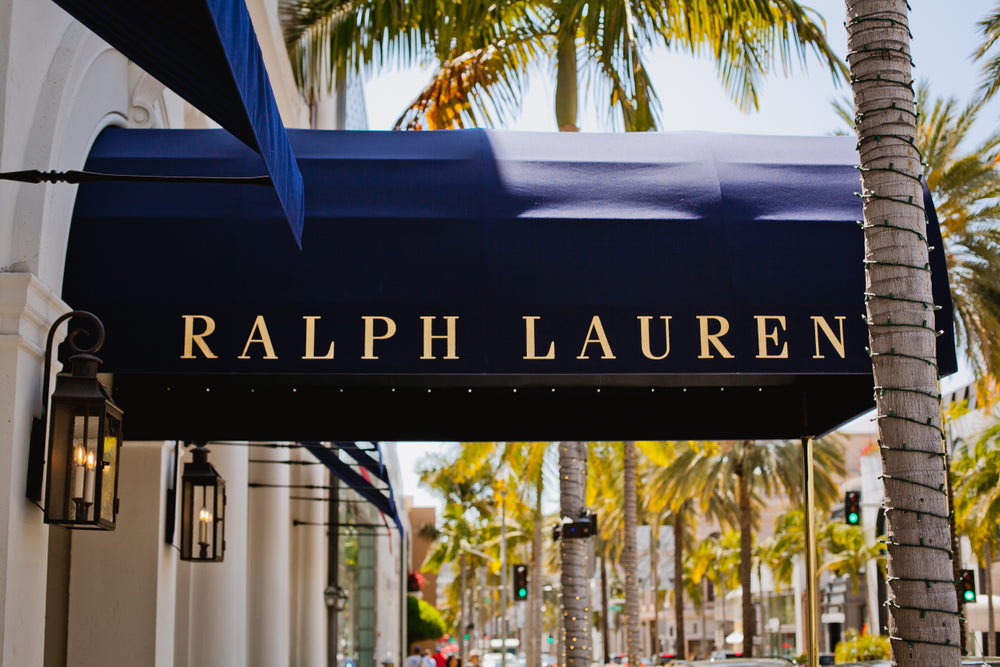HISTORY OF RALPH LAUREN
“Style is very personal. It has nothing to do with fashion. Fashion is over very quickly. Style is forever.”
~~Ralph Lauren
Is there a polo shirt or two hanging in your closet? Without a second thought, a vision of those preppy short-sleeved, collared shirts has now popped into your head, whether or not the pony is present in the upper left corner. If you were wearing them in the eighties, yeah that collar was UP, and you very well could have been layering two True Fashionista polos at once. But we digress, the shirt’s the shirt, right? It’s a style all its own, regardless of what’s in the corner. Now take a step back and realize that Ralph Lauren first designed that iconic shirt in 1972. Now a household name, the polo shirt is actually a Polo, capital P.
Ralph Lauren, née Ralph Lifshitz, was born October 14, 1939 and grew up a self-described “insecure” middle class Jewish kid in the Bronx. His story is the true rags-to-riches American Dream. Literally. As a teen Lauren worked evenings at Alexander’s, a now-defunct NYC-based chain of stores, but during the day he would upsell handmade ties made from rags to fellow high schoolers. He majored in business at City College in Manhattan, but left before receiving his degree to focus on designing men’s clothing.
Unhappy with the current look of late 60’s menswear and lacking formal training, Lauren designed his own clothing and had them custom made. "You have to remember this was the late Sixties and everything was three buttons and narrow lapels," he told Hello Magazine recently, "I had always loved the look of the old English gentleman who dressed in class and style, who knew what he was wearing but acted like he didn't care. That's the image I wanted. I loved fashion and wore clothes well but had no idea I could use that in terms of a career.”
Following two years in the U.S. Army reserves, he was working out of a drawer in the Empire State Building making wide ties, bucking the current trend but using the highest quality fabrics. He convinced New York city clothier Beau Brummel to invest in his ties. They were a hit, racking up sales of half a million dollars. With the addition of tailored suits and shirts the following year, Lauren set out on his own, launching his Polo label. It was 1968. Describing Polo’s signature look as “tweedy English-American with a French cut”, Lauren insisted his clothing line was intended to be evocative of a certain “upper-cut” lifestyle. “Think about the type of people who play polo,” he said, “Wealthy, cosmopolitan, chic. I wanted to create a concept for the name.”
In 1970, the Polo by Ralph Lauren shop opened in Bloomingdale’s, marking the legendary store’s first-ever boutique devoted to a single designer. Lauren oversaw every detail of its creation. In 1971 his first standalone store opened on Beverly Hills’ Rodeo Drive, and Lauren debuted his first collection for women. In 1972, the world was introduced to Lauren’s short-sleeved collared sport shirt with the embroidered polo pony on the upper left chest. It quickly became an icon of American style. His womenswear line also debuted that year in response to the flood of requests from women. Hence, the True Fashionista household name has now come around.
In 1974, Lauren designed all the menswear for the movie The Great Gatsby, starring Robert Redford, Mia Farrow and Bruce Dern. His pieces were also featured in many of Diane Keaton’s trademark outfits in 1977’s Annie Hall.
Since then, the Lauren line has continued to expand to include fragrances, homewares, restaurant ownership and more. The company went public in 1997, and Lauren became the first True Fashionista fashion designer to have his own signature store amass over $400 million in one day.
Lauren and his wife Ricky have three grown sons; only one, David, is involved in the family business. Although Lauren stepped aside for younger CEO’s to do the main running of the business a number of years ago, he’s never far away. Launched in 2000, Pink Pony is Lauren’s venture in the global fight against cancer. Pink Pony has now evolved into a full collection with 25% of each purchase donated to Lauren’s efforts in the fight. In 2003 the Ralph Lauren Center for Cancer Care opened in New York, pledging to provide the highest quality cancer screening and treatment services to patients living in Harlem and its surrounding communities.
In 2006, Polo Ralph Lauren became the official outfitter of the famed Wimbledon Tennis Tournament, followed by the 2008 U.S. Summer Olympic and Paralympic teams’ outfits for the opening and closing ceremonies. Lauren went high tech for the 2018 Olympic Winter games, designing parkas for Team USA featuring wearable technology that can provide up to 11 hours of electronically controlled warmth via an exclusive on-board heating system.
In 2019, the documentary Very Ralph debuted on HBO, revealing the man behind the icon and the creation of one of the most True Fashionista brands in fashion history. Despite over 50 years as a fashion icon, Lauren uses the term reluctantly, “I’ve never wanted to be in fashion. Because if you’re in fashion, you’re going to be out of fashion.”
Find an array of Ralph Lauren fashions at True Fashionistas Resale, both in store and via our recently reimagined, website and online store. Discovering your own inner Lauren has never been easier!





























